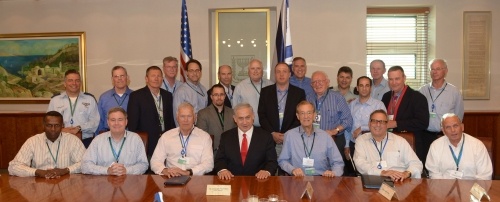Report: 2014 Generals and Admirals Program
In May, JINSA took a group of twelve recently retired generals and admirals to Israel through its Generals and Admirals (G&A) Program to participate in discussions with senior Israeli security, military, intelligence, and political leaders. The visit is an annual component of JINSA’s G&A Program, which was established in 1981 to educate retired U.S. general officers on the importance of a robust U.S.-Israel security partnership to America’s national security. This year JINSA created an extensive pre-trip education process that included briefings by leading U.S. and Israeli experts. The actual trip featured over 30 briefings with senior policymakers, military commanders, and intelligence officials, including Prime Minister Benjamin Netanyahu, Foreign Minister Avidor Lieberman, IDF Chief of Staff LTG Benjamin Gantz, Mossad Director Tamir Pardo, the Chiefs of Staff of the Israeli Air Force and Navy, and the commanders of Israel’s Gaza, Central, Northern, and Home Front Commands and Unit 8200. Additionally, Israel’s Defense and Armed Forces Attache to the United States and Canada, Major General Yaakov Ayish joined the trip.

The 2014 JINSA Generals and Admirals delegation meets with Prime Minister Benjamin Netanyahu during their visit.
In addition to these briefings on the Middle East security situation, the latest Israeli war fighting doctrine and national security plans, and joint U.S.-Israeli security and technological initiatives, the delegation visited eight Israeli military bases and five field locations, including: the Gaza “Terror” Tunnels; the Yam Tethys natural gas platforms; an Iron Dome Battery outside Ashkelon; the Jordan River Valley; and the Golan Heights. Although the JINSA delegation has visited Jordan for meetings with officials from the Jordanian military and intelligence services as part of the G&A Program since 1999, this year Jordanian leaders were unavailable due to preparations for the visit to the region by Pope Francis. This portion of the program will resume again next year.
This report is divided into four sections. The first section examinesstrategic threatsto Israel that if left unchecked will be capable of imposing a catastrophic defeat on the country that potentially threatens its existence as a sovereign nation or as a Jewish state. The second section examines unique operational challenges the Israeli Defense Forces (IDF) face in executing their mission to defend Israel’s territorial integrity and the security of its citizenry. The third section examines resources and assets that enable the IDF to successfully fulfill its mission. The report’s conclusion summarizes questions and/or concerns relating to Israel and the security situation in the Middle East that remain unresolved at the end of the ten-day trip.
This report is based upon the briefings and discussions the JINSA G&A Program delegation held with Israeli leaders and officers in May 2014, a month before the abduction and murder of three Israeli teenagers by Hamas operatives that precipitated the events culminating in the 51- day Operation Protective Edge. Despite the tragic loss of life during the fighting between Israel and Hamas, neither the military operations nor the August 26 ceasefire significantly altered Israel’s fundamental strategic or operational challenges the IDF faces. In fact, although none of the Israeli briefers conveyed an inkling that a major conflict was imminent, Operation Protective Edge validated many of their assessments about their adversaries’ military capabilities and tactics and vividly confirmed their predictions regarding the nature of future IDF operations. Therefore, none of the conclusions in this report have been altered to reflect the events of this summer’s war.